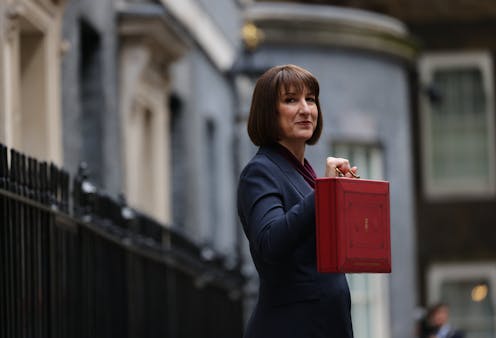
Labour’s first budget in 14 years appears to have avoided the Halloween nightmares that many predicted. Yes, the overall tax burden is at its highest level since 1948, but this budget’s tax and spend distribution is such that it spreads both the pain and the benefit. Most of the pain has been focused on the well off, sparing others from increased taxation.
This was, as is so often the case, a budget that was more about politics than economics.
The political emphasis is naturally very different from the previous Conservative administration. Like the 1990s governments of Tony Blair, Labour is now focusing on improving the public sector rather than cutting taxes.
The government claims there will be no return to austerity. Instead, Reeves’s budget is based not only on investment and growth, but education – which gets a 19% real-terms funding uplift. An extra £22 billion is also available for the NHS. Perhaps more importantly, there is an attempt to shift away from hospital-based provision to preventative approaches and community care.
This is a budget centred on redistribution. Taxes are increasing for employers (through increased national insurance) and on inheritance tax and capital gains. Second home owners, non-doms and parents sending their children to private school will also be taxed more. Beneficiaries include those on a minimum wage, pensions and carers.
Want more politics coverage from academic experts? Every week, we bring you informed analysis of developments in government and fact check the claims being made.
Sign up for our weekly politics newsletter, delivered every Friday.
It is, then, very much a Labour budget. It focuses on taking money from what may be called the upper middle class and the very well off, and spending it on the public sector, the lower paid and the worse off in society. Even the hinted-at increases on taxes around pensions and pension pots were not fulfilled for fear of alienating Labour supporting, public sector workers.
Delivering a vision
From this perspective, the budget can be regarded as a political success. It has done what Keir Starmer’s government has hitherto failed to do: set out a new, distinct agenda. Revising the existing fiscal rules to include both new stability and investment rules highlights Labour’s commitment to longer-term growth, which it hopes will secure the investment for renewed public services.
This strategy harks back to the traditional social democracy that runs from Tony Crosland – one of the foremost Labour thinkers on a reformed social democracy – and the Labour governments of the 1960s to New Labour. Economic growth, rather than the radical redistribution of wealth associated with Labour leaders such as Michael Foot and Jeremy Corbyn, is Labour’s mechanism for enhancing public services and improving the position of the worst off in society.

But therein lies the rub. The initial market reaction was good. Much of Reeves and Starmer’s pre-budget spin was about making sure the markets remained calm. There was no repeat of the Liz Truss and Kwasi Kwarteng mini-budget debacle, where unfunded tax cuts led to the unstable economic conditions and ultimately Truss’s downfall.
The whole of the Labour government strategy is based on modest but consistent economic growth between a high of 2% and a low of 1.5% between now and 2030. But, of course, economic growth is very difficult to predict and dependent on conditions that the government does not control.
Just this week, Israel’s decision not to target Iranian oilfields led to a 20% drop in oil prices. But any intensification of war in the Middle East could see that situation rapidly reversed.
So while Labour’s promise to increase capital spending and greater investment in science, research and development is important for growing the economy, it is only one factor and others may thwart Labour’s growth plan.
There is though one important lesson from history. All – and that really is all – Labour governments have ended their time in office amidst a financial crisis. Often, it is not directly of their own making, but the plight of the economy has subsequently undermined their original spending plans.
Reeves’s first budget has seen clear benefits for particular sectors. The adaptation of the fiscal rules creates new opportunities for growth through borrowing, capital spending and investment. Yet whether it can trigger the scale of economic takeoff needed to overcome the backlog of investment in public services is to be seen. This may well prove to be the key factor in determining both the longevity and legacy of this Labour government.
Martin Smith receives funding from Leverhulme Major Research Fellowship and Nuffield Foundation.
Dave Richards receives funding from two projects related to this article: 1. 'Public Expenditure, Planning and Control in Complex Times' - Nuffield Foundation, https://sites.manchester.ac.uk/public-expenditure-planning-and-control/ 2. 'The UK Productivity-Governance Puzzle: Are UK’s Governing Institutions Fit for Purpose in the 21st Century?' - The ESRC Productivity Institute https://www.productivity.ac.uk/people/professor-david-richards/
Sam Warner receives funding from the Nuffield Foundation.
This article was originally published on The Conversation. Read the original article.







